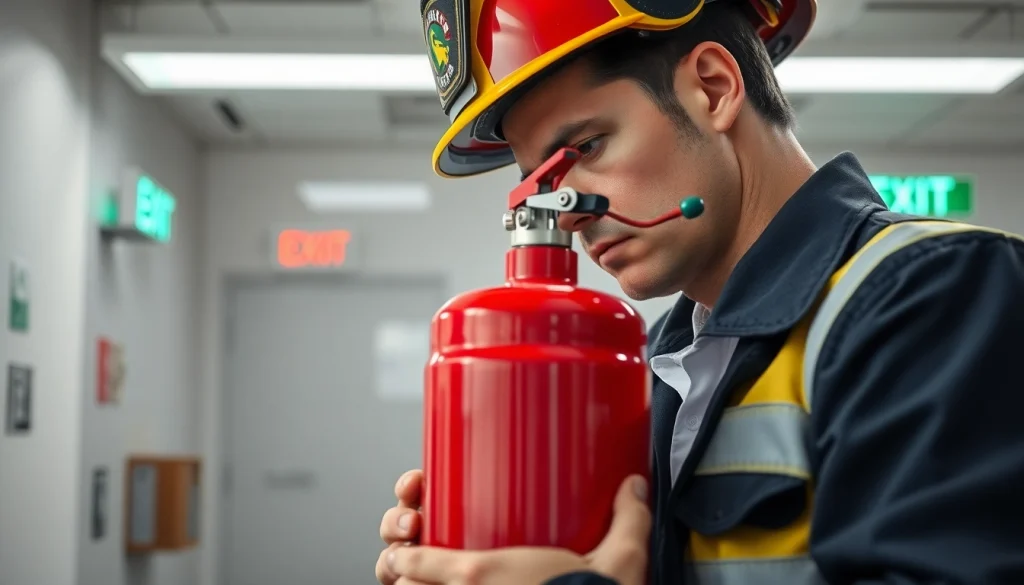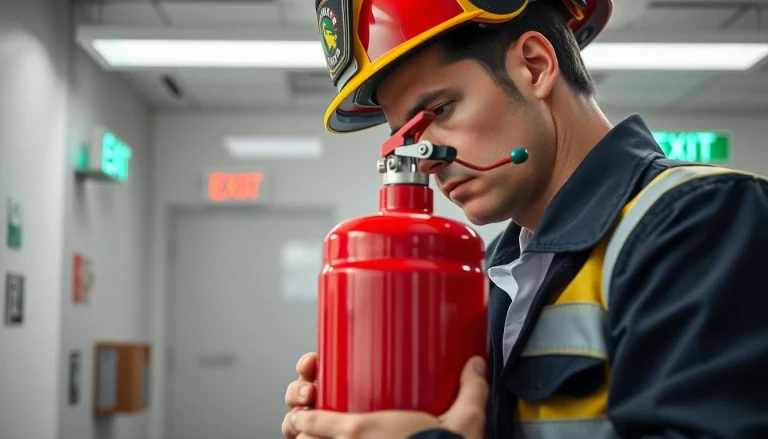
Understanding Fire Extinguisher Checks
What Are Fire Extinguisher Checks?
Fire extinguisher checks are systematic evaluations conducted to ensure that fire extinguishers are functioning properly and are ready for use in case of an emergency. These checks involve visual inspections, physical assessments, and sometimes pressure tests that verify the effectiveness and reliability of these critical safety devices. Regular checks, as stipulated by fire safety standards, are essential to ensure that extinguishers are not only present but also in optimal working condition. For both commercial properties and residential areas, the significance of regular fire extinguisher checks cannot be overstated; they serve as a first line of defense against fire incidents.
The Importance of Regular Inspections
Conducting regular fire extinguisher checks is crucial for several reasons. First and foremost, they ensure compliance with local and national fire safety regulations, which require that fire extinguishers are designed, maintained, and periodically inspected to perform as intended. Secondly, regular inspections are integral in identifying potential issues before they become serious problems. For instance, a simple visual check can help detect issues like rust or a missing inspection tag, which could hinder the extinguisher’s effectiveness during an emergency. Furthermore, maintaining fire extinguishers not only safeguards lives but also protects properties, ensuring that reliable fire protection is always at hand.
Legal Requirements for Fire Extinguisher Checks
Legal requirements regarding fire extinguisher checks are influenced by various regulations such as the National Fire Protection Association (NFPA) standards. NFPA 10 outlines the minimum requirements for the selection, installation, inspection, maintenance, and testing of portable fire extinguishers. According to NFPA 10, extinguishers need to be inspected at least once each month and undergo a more thorough annual maintenance check by a qualified technician. Moreover, specific industries may have additional requirements governed by OSHA or state and local fire codes. Understanding these legalities is essential for businesses, as non-compliance can lead to severe fines and increased liability in the event of a fire incident.
Implementing Effective Fire Extinguisher Checks
Step-by-Step Guide to Monthly Checks
Monthly checks are a fundamental component of fire safety management. Here’s a step-by-step guide to performing these checks effectively:
- Accessibility: Ensure that the extinguisher is located in a clear, easily accessible space, free from obstructions.
- Physical Condition: Inspect the outside of the extinguisher for any visible signs of damage, such as dents, rust, or corrosion.
- Pressure Gauge: Check the pressure gauge to ensure that it is within the operational range as indicated by the green zone; if it’s in the red zone, the extinguisher needs to be serviced.
- Inspection Tag: Look for the inspection tag; it should reflect a current inspection date. If it’s missing, replace it to ensure compliance.
- Seals and Pins: Inspect seals and pins for any signs of tampering. If the seal is broken or the pin is missing, take necessary actions to re-service the extinguisher.
- Documentation: Record the findings of your inspection, reporting any issues requiring attention and ensuring all checks are documented.
Common Issues to Look for During Inspections
During fire extinguisher checks, several common issues can arise that should be carefully monitored:
- Dents and Deformities: Physical damage can affect how a fire extinguisher performs. Dents may indicate internal damage that is not visible.
- Rust and Corrosion: These can weaken the structural integrity of the extinguisher, potentially leading to failure during use.
- Leaking or Low Pressure: If the pressure gauge indicates low pressure, it may mean the extinguisher will not work when needed. Regular checks allow quick identification.
- Inaccessible Locations: Ensure the extinguisher is positioned in a visible and easily accessible area; this can save crucial seconds in an emergency.
- Expired Inspection Tags: Keeping the inspection tag up to date is crucial for compliance and operational checks; outdated tags indicate a need for professional service.
Documentation and Reporting
Documentation is an integral part of fire extinguisher checks. It ensures that all inspections and maintenance activities are formally recorded, which is essential for compliance and safety audits. A typical documentation process includes:
- Inspection Log: Maintain a detailed inspection log that documents the date of inspection, any issues found, corrective actions taken, and the person responsible for the check.
- Follow-Up Actions: Any need for service or repairs identified during checks should be documented, and follow-up actions should be scheduled and recorded.
- Compliance Records: Keep copies of any compliance-related documents, including service agreements and manufacturer certifications. This records should be easily accessible during inspections or audits.
Different Types of Fire Extinguishers
Understanding Various Fire Extinguisher Classifications
Fire extinguishers are classified based on the type of fire they are designed to extinguish. Familiarity with these classifications is essential for effective fire safety management:
- Class A: For ordinary combustibles like wood, paper, and cloth.
- Class B: Suitable for flammable liquids such as gasoline, oil, and grease.
- Class C: For electrical fires involving appliances and wiring.
- Class D: Designed for combustible metals, typically used in specific industrial settings.
- Class K: For cooking oils and fats, commonly found in kitchen and restaurant settings.
Choosing the Right Extinguisher for Your Needs
Choosing the right fire extinguisher involves more than understanding classification; it requires a careful assessment of the environment and potential fire risks. Considerations include:
- Environment: Assess the environmental risks based on the materials present in the area.
- Usage Frequency: High-risk areas should have extinguishers easily available, where they can be reached quickly.
- Staff Training: Ensure that personnel are trained in the specific extinguishers available in their environment—this can greatly improve response times in emergencies.
How Different Extinguishers Require Different Checks
Different classes of fire extinguishers require tailored checks and maintenance routines. Here are some examples:
- Class A Extinguishers: Often may only require visual checks unless they are used for extensive fires, where recharge may be necessary.
- Class B Extinguishers: In addition to monthly checks, they should be recharged immediately after use, and more frequent inspections may be warranted.
- Class C Extinguishers: Ensure that the physical condition is maintained, as they contain gases that can leak over time.
- Class D Extinguishers: Regular checks should assess any corrosive substances that could affect functionality.
- Class K Extinguishers: As these are used primarily in kitchen settings, ensure accessibility and cleanliness, as grease buildup can obstruct their use.
Fire Extinguisher Maintenance Strategies
Annual Maintenance vs. Monthly Checks
While monthly checks are crucial for ensuring extinguishers are ready for use, annual maintenance is equally important. This maintenance typically involves:
- Comprehensive Inspection: A qualified technician performs a detailed inspection, checking the internal components and functionality.
- Hydrostatic Testing: This testing is required at specified intervals for certain extinguisher types to ensure they can safely withstand pressure.
- Professional Servicing: Any repairs or recharges necessary following an inspection are performed by professionals to ensure safety and compliance.
Expert Recommendations for Long-Term Care
To ensure long-term effectiveness, consider these expert recommendations:
- Install in Strategic Locations: Ensure extinguishers are easily visible and promptly accessible during emergencies.
- Regular Training: Schedule regular training sessions for staff on how to use extinguishers effectively.
- Conduct Drills: Integrate extinguisher drills into fire safety training programs to build familiarity and speed in cases of use.
- Monitor Expiry Dates: Each extinguisher has a lifespan. Regular checks should include verifying expiration dates or due for servicing.
When to Replace Fire Extinguishers
Replacement of fire extinguishers is essential for maintaining safety standards. Indicators for replacement include:
- Age: Check manufacturer recommendations; many extinguishers have a life span of 5 to 15 years.
- Physical Damage: Any major dents or corrosion may necessitate the replacement of the unit.
- Failed Maintenance Tests: Any extinguisher that fails its annual or biannual inspection should be replaced immediately to ensure safety.
- Outdated Technology: If your extinguishers do not meet the latest safety standards or technology, consider replacing them for updated models.
Advanced Fire Safety Planning
Integrating Fire Extinguisher Checks into Safety Drills
Incorporating fire extinguisher checks into safety drills is an effective strategy for ensuring readiness. Safety drills should involve:
- Mock Scenarios: Create realistic fire scenarios where participants must locate and use extinguishers correctly.
- Feedback Sessions: After drills, conduct feedback discussions to enhance practices and address any weaknesses in preparation.
- Consistent Rehearsals: Schedule regular drills to maintain preparedness and reinforce the importance of effective extinguisher checks.
Training Staff on Fire Extinguisher Use and Checks
Training staff on the correct usage and checks of fire extinguishers is vital. Effective training programs should include:
- Hands-On Demonstrations: Provide practical demonstrations of how to use various classes of extinguishers.
- Periodic Refresher Courses: Regular training updates ensure knowledge remains current and effective.
- Incorporating Checklists: Distributing checklists to staff can aid memory recall during inspections and drills.
Future Trends in Fire Safety Compliance
As technology and regulations evolve, so will fire safety compliance. Potential future trends may include:
- Smart Technology: The integration of smart technology in extinguishers for real-time monitoring and alerts could enhance safety measures considerably.
- Increased Automation: Automated inspections systems may pave the way for more reliable and consistent checks.
- Bio-Based Extinguishing Agents: Research into more environmentally friendly extinguishing agents is likely to rise, promoting sustainability in fire safety.






